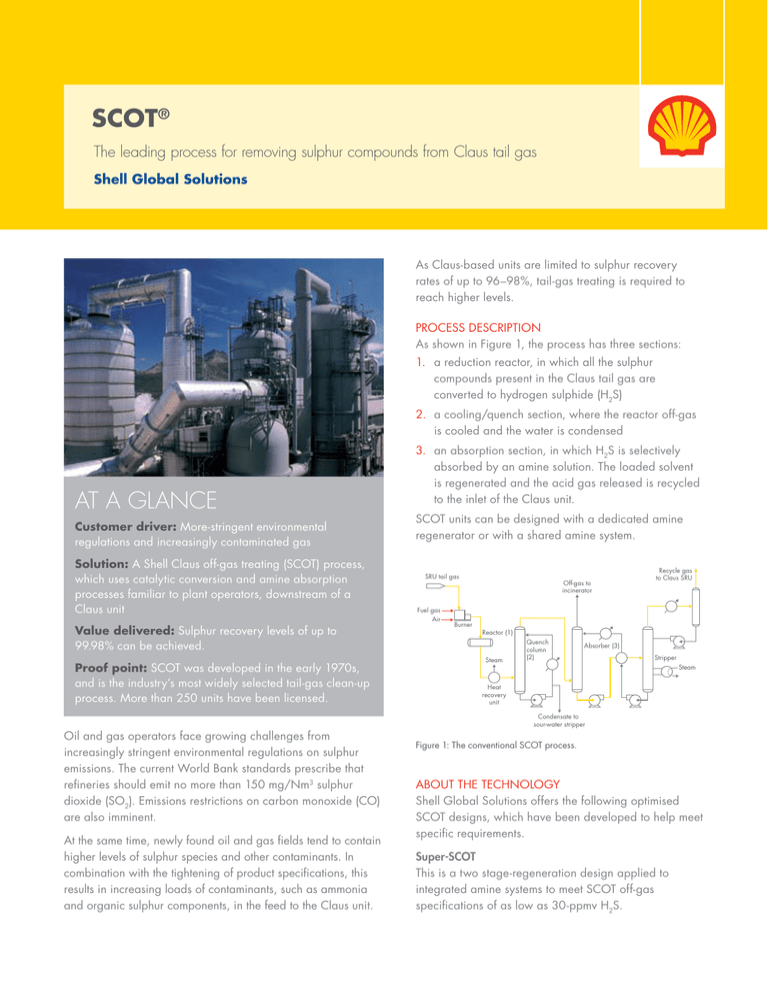
SCOT®
The leading process for removing sulphur compounds from Claus tail gas
Shell Global Solutions
As Claus-based units are limited to sulphur recovery
rates of up to 96–98%, tail-gas treating is required to
reach higher levels.
PROCESS DESCRIPTION
As shown in Figure 1, the process has three sections:
1. a reduction reactor, in which all the sulphur
compounds present in the Claus tail gas are
converted to hydrogen sulphide (H2S)
2. a cooling/quench section, where the reactor off-gas
is cooled and the water is condensed
AT A GLANCE
Customer driver: More-stringent environmental
regulations and increasingly contaminated gas
Solution: A Shell Claus off-gas treating (SCOT) process,
which uses catalytic conversion and amine absorption
processes familiar to plant operators, downstream of a
Claus unit
Value delivered: Sulphur recovery levels of up to
99.98% can be achieved.
Proof point: SCOT was developed in the early 1970s,
and is the industry’s most widely selected tail-gas clean-up
process. More than 250 units have been licensed.
Oil and gas operators face growing challenges from
increasingly stringent environmental regulations on sulphur
emissions. The current World Bank standards prescribe that
refineries should emit no more than 150 mg/Nm3 sulphur
dioxide (SO2). Emissions restrictions on carbon monoxide (CO)
are also imminent.
At the same time, newly found oil and gas fields tend to contain
higher levels of sulphur species and other contaminants. In
combination with the tightening of product specifications, this
results in increasing loads of contaminants, such as ammonia
and organic sulphur components, in the feed to the Claus unit.
3. an absorption section, in which H2S is selectively
absorbed by an amine solution. The loaded solvent
is regenerated and the acid gas released is recycled
to the inlet of the Claus unit.
SCOT units can be designed with a dedicated amine
regenerator or with a shared amine system.
SRU tail gas
Fuel gas
Air
Burner
Off-gas to
incinerator
Recycle gas
to Claus SRU
Reactor (1)
Steam
Quench
column
(2)
Absorber (3)
Stripper
Steam
Heat
recovery
unit
Condensate to
sour-water stripper
Figure 1: The conventional SCOT process.
ABOUT THE TECHNOLOGY
Shell Global Solutions offers the following optimised
SCOT designs, which have been developed to help meet
specific requirements.
Super-SCOT
This is a two stage-regeneration design applied to
integrated amine systems to meet SCOT off-gas
specifications of as low as 30-ppmv H2S.
pRoof poINTs
New Zealand Refining Company
New Zealand Refining Company’s Whangarei
refinery cut its reactor internal temperature from
280°C to 250°C, which resulted in a 20–22%
reduction in fuel gas use, after adopting Criterion
Catalysts & Technologies’ low-temperature catalyst
C734 in its SCOT unit. It selected C734 because of its
catalytic activity and low pressure-drop characteristics.
The unit has shown stable operation since it started up
smoothly in May 2010.
Low-Sulphur (LS-) SCOT
This is the key technology for very low sulphur emissions (as
low as 10-ppmv H2S or 50-ppmv total sulphur). A small
concentration of an inexpensive additive is added to the
amine. This improves solvent regeneration and solvent
leanness. Alternatively, LS-SCOT can be used to reduce the
steam requirements and keep the H2S emission level constant.
US West Coast refinery
In 2008, a refinery on the US West Coast adopted
LS-SCOT. As a result, reboiler steam decreased 40%
without increasing environmental emissions. In
addition, by operating with lower steam rates, the
SCOT unit is now more resistant to process upsets.
The unit has operated for more than three years with
this technology, with no solvent degradation or
corrosion symptoms.
Low-Temperature (LT-) SCOT
To save fuel, minimise carbon dioxide (CO2) emissions and
maximise catalyst cycle length, a hydrogenation catalyst with
increased activity is used to enable the tail-gas treating reactor
to operate at lower inlet temperatures.
Mercaptan-destruction SCOT
To remove mercaptans, two parallel hydrogenation catalyst
beds are employed: one for the main Claus tail gas and one for
mercaptan-containing off-gases. This line-up is typically applied
in gas plants handling complex contaminated gas mixtures.
CO-SCOT
Unlike other tail-gas processes, CO-SCOT also reduces the
level of CO in the tail gas.
HAvE yOu CONsidErEd HOw yOu CAN
n
n
BUSINESS VALUE
SCOT technology enables very high levels of sulphur
recovery and very low levels of SO2 emissions to be
achieved. Consequently, it is a key process for fulfilling
increasingly stringent emission specifications, including
the most stringent World Bank standards.
Other benefits include:
n
n
effectively
meet the future regulations for SO2 and CO
emissions for your new or existing tail-gas treating unit?
cut the operating cost of your tail-gas treating unit?
n
n
High-performance gas-treating solutions series
FEED
GAS
AGRU
NGL
extraction
MSU
TREATED GAS
C2 treating
AGEU
LPG treating
SRU
Tail gas
treating
Sulphur
degassing
TO STACK
SULPHUR
n
n
high
flexibility – The process can operate over a wide
range of sulphur intakes. A turndown ratio of less than
10% of design throughput is achievable.
low
maintenance requirements – The unit requires little
operational attention.
excellent
reliability – Less than 1% unscheduled
downtime has been achieved in Shell-advised units.
reduced CO emissions.
good
tolerance to incomplete ammonia destruction in
the upstream Claus unit.
no troublesome secondary waste streams.
SCOT is a Shell trademark.
For further information, please visit our website at www.shell.com/globalsolutions
Shell Global Solutions is a network of independent technology companies in the Shell Group. In this
material, the expressions “the Shell Group”, “Shell” and “Shell Global Solutions” are sometimes
used for convenience where reference is made to these companies in general, or where no useful
purpose is served by identifying a particular company.
The information contained in this material is intended to be general in nature and must not be relied
on as specific advice in connection with any decisions you may make. Shell Global Solutions is not
liable for any action you may take as a result of you relying on such material or for any loss or
damage suffered by you as a result of you taking this action. Furthermore, these materials do not in
any way constitute an offer to provide specific services. Some services may not be available in
certain countries or political subdivisions thereof.
Copyright © 2011 Shell Global Solutions International BV. All rights reserved. No part of this
publication may be reproduced or transmitted in any form or by any means, electronic or
mechanical including by photocopy, recording or information storage and retrieval system, without
permission in writing from Shell Global Solutions International BV.
GS33780911 En(A)



